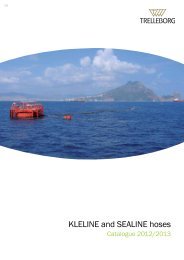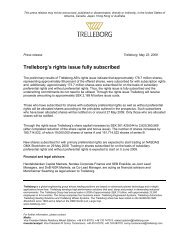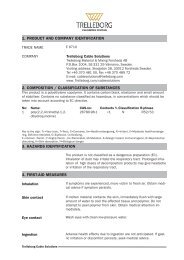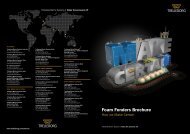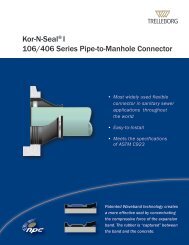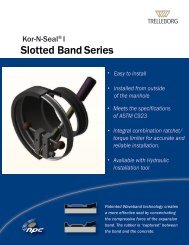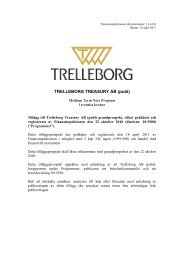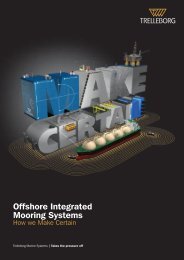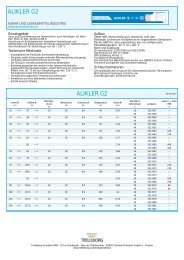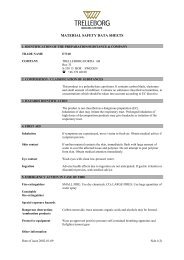Annual report 2011 - Trelleborg
Annual report 2011 - Trelleborg
Annual report 2011 - Trelleborg
You also want an ePaper? Increase the reach of your titles
YUMPU automatically turns print PDFs into web optimized ePapers that Google loves.
76<br />
NOTES – GROUP<br />
net after any recognition of impairment losses. The associated companies<br />
essentially carry out the same operations as the Group’s other business activities<br />
and, accordingly, the share of profit in these companies is recognized in<br />
operating profit.<br />
The Group’s share in the post-acquisition results of an associated company<br />
is recognized in profit and loss in the item “Share of profit or loss in associated<br />
companies,” and is included in operating income. Accumulated post-acquisition<br />
changes are recognized as changes in the carrying amount of the investment.<br />
When the Group’s share in the losses of an associated company amount to, or<br />
exceed, the Group’s investment in the associated company, including any unsecured<br />
receivables, the Group does not recognize further losses unless obligations<br />
have been incurred or payments made on behalf of the associated<br />
company. Unrealized gains on transactions between the Group and its associated<br />
companies are eliminated in proportion to the Group’s participation in the<br />
associated company. Unrealized losses are also eliminated, unless the transaction<br />
provides evidence of an impairment of the transferred asset.<br />
Joint ventures<br />
A joint venture pertains to an agreement-based relationship in which two or<br />
more parties jointly conduct a financial operation and have a joint controlling<br />
influence over the business. Investments in joint ventures are recognized in<br />
accordance with the equity method, similar to investments in associated<br />
companies.<br />
Transactions with non-controlling interests<br />
Transactions with non-controlling interests are treated as transactions with the<br />
Group’s shareholders. This means that, in connection with an acquisition from a<br />
non-controlling interest, the difference between the purchase consideration paid<br />
and the actual share acquired of the carrying amount of the subsidiary’s net<br />
assets is recognized in equity. Gains and losses on divestments to non-controlling<br />
interests are also recognized in equity.<br />
Discontinuing or divested operations<br />
Discontinuing or divested operations comprise significant parts of operations<br />
and assets that the Group has determined to fully, or almost fully, discontinue or<br />
divest through disposal or distribution. These assets are recognized at the lower<br />
of the carrying amount and fair value, less selling expenses. These non-current<br />
assets are not depreciated from the date of reclassification.<br />
Translation of foreign currencies<br />
Functional currency and <strong>report</strong>ing currency<br />
Items included in the financial statements of the various entities of the Group<br />
are valued in the currency used in the primary economic environment of each<br />
company’s operations (functional currency). Swedish kronor (SEK), which is the<br />
Parent Company’s functional currency and presentation currency, is utilized in<br />
the Group accounts.<br />
Transactions and balance-sheet items<br />
Transactions in foreign currency are translated into the functional currency in<br />
accordance with the exchange rate prevailing on the transaction date. Exchangerate<br />
gains and losses resulting from settlement of such transactions and from<br />
the translation at the closing rate of monetary assets and liabilities in foreign<br />
currency are recognized in profit and loss. An exception is made when hedging<br />
transactions meet the requirements for cash-flow hedge or net-investments<br />
hedge whereby gains and losses are recognized directly against other comprehensive<br />
income after adjustment for deferred taxes. Reversal to profit and loss<br />
takes place at the same time as the hedged transaction impacts profit and loss.<br />
Subsidiaries<br />
The earnings and financial position of the Group subsidiaries and associated<br />
companies (none of which use a high-inflation currency) are prepared in the<br />
functional currency of each company. In the consolidated accounts, the earnings<br />
and financial position of foreign subsidiaries are translated into Swedish kronor<br />
(SEK) in accordance with the following: Income and expenses in the income<br />
statements of subsidiaries are translated at the average exchange rate for the<br />
applicable year, while assets and liabilities in the balance sheet are translated<br />
at the closing rate. Exchange-rate differences arising from translation are recognized<br />
as a separate item in other comprehensive income.<br />
Translation differences arising on financial instruments, which are held for<br />
hedging of net assets in foreign subsidiaries, are also entered as a separate<br />
item in other comprehensive income. On divestment, the accumulated translation<br />
differences attributable to the divested unit, previously recognized in other<br />
comprehensive income, are realized in the consolidated income statement in<br />
the same period as the gain or loss on the divestment.<br />
Goodwill and adjustments of fair value arising in connection with the acquisition<br />
of foreign operations are treated as assets and liabilities of these operations,<br />
and are translated at the closing rate.<br />
Income tax<br />
Income tax in the income statement includes both current tax and deferred tax.<br />
Income tax is recognized in profit and loss except when an underlying transaction<br />
is recognized directly against equity or total comprehensive income, in<br />
<strong>Annual</strong> Report <strong>2011</strong> <strong>Trelleborg</strong> AB<br />
which case the related tax effect is also recognized in equity or total comprehensive<br />
income. Current tax is tax payable or recoverable for the current year. This<br />
also includes adjustment for current tax attributable to prior periods. Deferred<br />
tax is recognized in its entirety and calculated using the liability method on all<br />
temporary differences arising between the tax base of assets and liabilities and<br />
their carrying amounts in the consolidated accounts. Deferred tax is measured<br />
at the nominal amount and calculated by applying the tax rates and tax rules<br />
enacted or announced at the closing date. Temporary differences arise in business<br />
combinations on the differences between the consolidated value of assets<br />
and liabilities and their tax bases.<br />
Temporary differences that arise on initial recognition of an asset or liability,<br />
and which are not attributable to a business combination and have not affected<br />
recognized or taxable earnings, do not entail a deferred tax asset or tax liability<br />
in the balance sheet. Temporary differences are not recognized for investments<br />
in subsidiaries and associated companies, as the Group can control the date<br />
when these temporary differences are reversed and when it is unlikely that they<br />
will be reversed in the foreseeable future.<br />
Deferred tax assets are recognized insofar as it is probable that tax<br />
surpluses will be available in the future against which temporary differences can<br />
be utilized.<br />
Segment <strong>report</strong>ing<br />
Operating segments are <strong>report</strong>ed in a manner consistent with the internal<br />
<strong>report</strong>s presented to the chief operating decision maker. The chief operating<br />
decision maker is the function responsible for the allocation of resources and<br />
the assessment of the segments’ earnings. For the Group, this function has<br />
been identified as the President. The division of operating segments corresponds<br />
to the Group’s business areas. For a description of the various<br />
segments, see pages 8-15.<br />
The Group is divided into four business areas: <strong>Trelleborg</strong> Engineered<br />
Systems, <strong>Trelleborg</strong> Automotive, <strong>Trelleborg</strong> Sealing Solutions and <strong>Trelleborg</strong><br />
Wheel Systems.<br />
Segment <strong>report</strong>ing for the business areas comprises operating revenues<br />
and expenses and capital employed. Capital employed encompasses all property,<br />
plant and equipment, intangible assets and investments in associated<br />
companies, plan assets, inventories and operating receivables, less operating<br />
liabilities including pension liabilities.<br />
The business areas are charged with Group-wide expenses amounting to<br />
0.4 percent of external sales, which does not affect recognized cash flows.<br />
In the presentation of the Group’s geographical markets, the operations<br />
have been subdivided into the Group’s key geographical markets, which are<br />
Western Europe, North America and Rest of the World.<br />
Net sales are recognized according to customer location, while assets and<br />
capital expenditures are recognized according to the actual physical location of<br />
these assets.<br />
Other accounting and valuation policies<br />
Non-current assets and non-current liabilities comprise amounts expected to be<br />
recovered or paid more than 12 months from the closing date. Current assets<br />
and current liabilities comprise amounts expected to be recovered or paid within<br />
12 months of the closing date. Assets and liabilities are measured at cost,<br />
unless otherwise indicated.<br />
Revenue recognition<br />
Revenue comprises the fair value of the amount that has been received, or will<br />
be received, for goods and services sold in the Group’s operating activities, less<br />
VAT and discounts, and after elimination of intra-Group sales. Revenue is recognized<br />
as follows:<br />
Sales of goods<br />
Revenue from sale of goods is recognized during the period in which the product<br />
is delivered and when all significant risks and rewards related to ownership have<br />
been transferred to the buyer. Accordingly, the Group no longer has any involvement<br />
in the goods that is ownership-related, nor does it exercise any real control<br />
over the goods when revenue is recognized. Net sales are recognized after<br />
deduction of VAT and are adjusted for any discounts, as well as exchange-rate<br />
differences in connection with sales conducted in foreign currencies.<br />
Contract and service assignments<br />
Revenue recognition is conducted using the percentage-of-completion method.<br />
Revenue is recognized on the basis of the stage of completion whereby it is<br />
probable that the company will obtain the financial benefits related to the<br />
assignment, and when a reliable calculation can be made. The stage of completion<br />
is determined on the basis of costs incurred in relation to total calculated<br />
costs. Anticipated losses are expensed immediately.<br />
Royalty revenue<br />
Royalty revenue is recognized on an accruals basis in accordance with the financial<br />
conditions of the relevant agreements.<br />
Interest income<br />
Interest income is recognized on a time-proportion basis using the effective<br />
interest method.




